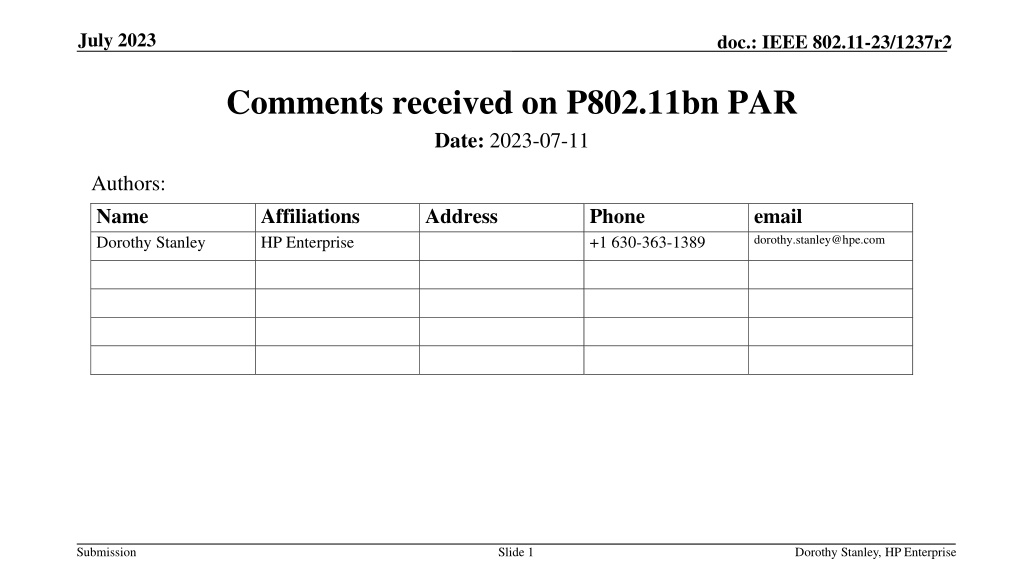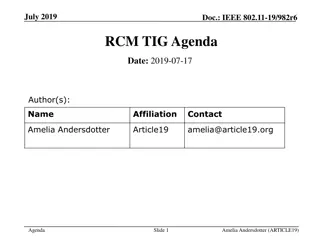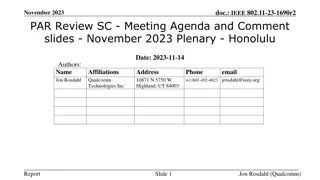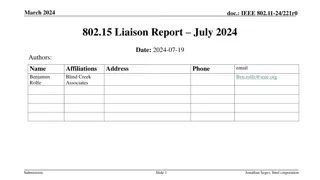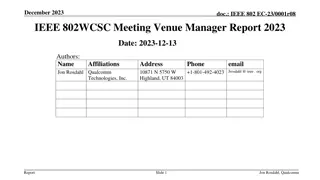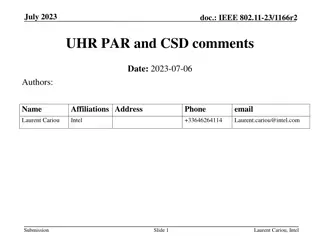IEEE 802.11-23/1237r2 Comments Review Summary
This document presents comments received on the IEEE 802.11-23/1237r2 draft, including feedback from Paul Nikolich, James Gilb, and various IEEE working groups. Key points highlighted include proposals for enhancing technologies, addressing cost factors, defining reliability requirements, and specifying numerical targets for feature improvements.
Uploaded on Apr 17, 2024 | 2 Views
Download Presentation

Please find below an Image/Link to download the presentation.
The content on the website is provided AS IS for your information and personal use only. It may not be sold, licensed, or shared on other websites without obtaining consent from the author.If you encounter any issues during the download, it is possible that the publisher has removed the file from their server.
You are allowed to download the files provided on this website for personal or commercial use, subject to the condition that they are used lawfully. All files are the property of their respective owners.
The content on the website is provided AS IS for your information and personal use only. It may not be sold, licensed, or shared on other websites without obtaining consent from the author.
E N D
Presentation Transcript
July 2023 doc.: IEEE 802.11-23/1237r2 Comments received on P802.11bn PAR Date: 2023-07-11 Authors: Name Dorothy Stanley Affiliations HP Enterprise Address Phone +1 630-363-1389 email dorothy.stanley@hpe.com Submission Slide 1 Dorothy Stanley, HP Enterprise
July 2023 doc.: IEEE 802.11-23/1237r2 Abstract This document contains comments received from: Paul Nikolich (2 comments) James Gilb (13 comments) 802.15 (6 comments, preliminary) 802.3 ( 7 comments, included for completeness, originally in 11-23-1080) 802.1 (6 comments) See 11-23-1080 for comments from 802.3 Submission Slide 2 Dorothy Stanley, HP Enterprise
July 2023 doc.: IEEE 802.11-23/1237r2 Nikolich: CSD (2 comments) 1) In 1.2.4.b I suggest replacing "The increased capabilities envisioned for the baseband and RF parts necessary to implement the proposed amendment are in line with the current progress in technology and not expected to impinge testability." with "The increased capabilities envisioned for the MAC, baseband signal processing and RF technologies necessary to implement the proposed amendment are in line with the current progress of those technologies as demonstrated by lab testing, modeling and simulations." 2) There appears to be a cut-and-paste error in the 1.2.5.a and 1.2.5b of the CSD (see below). I suggest swapping the text under (a) and (b). 1.2.5.a) Known cost factors. WLAN equipment is accepted as having balanced costs. The development of Wireless capabilities to enhance the throughput and improve latency of WLAN network deployments will not disrupt the established balance. 1.2.5.b) Balanced costs. Support of the proposed standard will likely require a manufacturer to develop a modified radio, modem and firmware. This is similar in principle to the transition between IEEE 802.11ax and IEEE 802.11be as well as in previous iterations of IEEE Std. 802.11 enhancements. The cost factors for these transitions are well known and the data for this is well understood. Submission Slide 3 Dorothy Stanley, HP Enterprise
July 2023 doc.: IEEE 802.11-23/1237r2 Gilb: PAR 2.1 (3 of 13 comments) 2.1 "Ultra High" violates the NesCom convention of not using comparative words rather than specific numbers. You need to specify somewhere what "Ultra High" means. (Also, it would be Ultra-High Reliability). 2.1 How is reliability defined? No where do I find out what type of reliability is being sought. You need a different title for this that matches the description in the scope. I don't see any proposed additions that address reliability of any kind. Submission Slide 4 Dorothy Stanley, HP Enterprise
July 2023 doc.: IEEE 802.11-23/1237r2 Gilb: PAR 5.2.b (5 of 13 comments) - The three items specified use "increasing", "improving" and "improving" with no numerical targets. This would imply that any tiny change would justify adding the new feature. Replace these with numerical targets, e.g., 50% more throughput. - If you are going to compare to EHT MAC/PHY, there needs to be a documented measurement for the baseline, or at least some sort of agreed upon method. This method needs to be referenced. - How is "tail of the latency distribution and jitter" "improved"? What is the definition of "tail". At what value has the distribution fallen off enough for it to be the "tail"? Are you decreasing the integral of the tail? - Efficient use of the medium does not uniquely define what is being sought. Is it bits/Hz? idle time? Specify the type of efficiency that is being improved and the numerical target. - How is the power save "enhanced"? What is the characteristic that is being measured with respect to power save? In the need, battery life and lower energy bills are referenced, but the scope doesn't address either. Submission Slide 5 Dorothy Stanley, HP Enterprise
July 2023 doc.: IEEE 802.11-23/1237r2 Gilb: PAR 5.5 (2 of 13 comments) - The need for the project states "align with a symmetrical broadband speed of 10 Gb/s", but nothing in the scope says that this performance target will be met. Is this a requirement for the amendment? If so, add it to the scope. If not, remove from Need. - Expand "P2P" on first use. Submission Slide 6 Dorothy Stanley, HP Enterprise
July 2023 doc.: IEEE 802.11-23/1237r2 Gilb: PAR 8.1 (3 of 13 comments) - "For example, a user experiencing marginal connectivity at the edge of a network today might experience improved connectivity with the defined enhancements." Will connectivity actually be improved with the changes? If so, how is connectivity measured and by what measure will it be improved? - "Conversely, an application (for example AR/VR) where the user experiences feedback lag under the current baseline might see reduced lag with the defined enhancements." The word "Conversely" doesn't belong here. Both can be true. Also, "might see reduced lag" isn't measureable. At some point the lag isn't noticeable. Is this a real problem and how will the proposed project address it? - "(Basis Service Set)" should just be ", BSS," (it is Basic, not Basis, anyway). Submission Slide 7 Dorothy Stanley, HP Enterprise
July 2023 doc.: IEEE 802.11-23/1237r2 802.15: PAR (4 comments) 1) PAR, 5.2.b fix suspect characters in the bullet list 2) PAR, 5.2b The way 5.2b is written requires that all bullets must be achieved to complete the project is that correct? 3) PAR, 5.2b it is not clear how these items relate to Ultra-High Reliability . Please quantify Ultra- High Reliability and clarify the relationship between throughput, latency and efficiency and Ultra-High Reliability . 4) PAR, 5.3 This standard appears to be dependent on 802.11be, which is not yet complete. Submission Slide 8 Dorothy Stanley, HP Enterprise
July 2023 doc.: IEEE 802.11-23/1237r2 802.15: CSD (2 comments) 5) CSD 1.2.3 states: There is no other WLAN standard focusing on improving WLAN throughput at different SINR levels in scenarios of an isolated BSS and overlapping BSSs, improving the tail of the latency distribution and jitter, enhancing mobility between BSSs, and providing mechanisms for enhanced power save for AP STAs (including mobile APs) other than this amendment. but the PAR states that the project is Enhancements for Ultra-High Reliability . Once again, the relationship between throughput, latency and efficiency and Ultra-High Reliability is not explained. 6) CSD 1.2.3 : There is no other WLAN standard focusing on improving WLAN throughput at different SINR levels in scenarios of an isolated BSS and overlapping BSSs Please confirm this statement is correct? Submission Slide 9 Dorothy Stanley, HP Enterprise
July 2023 doc.: IEEE 802.11-23/1237r2 802.3: PAR (2 of 6 comments) 2.1 It isn t clear if the project is addressing hardware reliability or transmission reliability. These are very different things and this should be significantly more clear. 5.2,b While the project scope may be technically accurate, it is very difficult to actually figure out what the goals of the project are. Please consider this in any rewrite. Submission Slide 10 Dorothy Stanley, HP Enterprise
July 2023 doc.: IEEE 802.11-23/1237r2 802.3: PAR (1 of 6 comments) 5.2.b The project scope begins with an extremely difficult to parse run-on sentence. It would be helpful to know if these enhancements will apply to all 802.11 PHY types, or only selected PHY types (all PHY types is assumed in the following proposed revision of the project scope because of the listing of frequencies). Would the following better introduce the bulleted list: This amendment defines modifications to both IEEE Std 802.11 physical layers (PHYs) and the IEEE Std 802.11 Medium Access Control (MAC). The modifications will add Ultra High Reliability capability to Wireless Local Area Network (WLAN) Basic Service Sets (BSSs) or overlapping BSSs by providing: Submission Slide 11 Dorothy Stanley, HP Enterprise
July 2023 doc.: IEEE 802.11-23/1237r2 802.3: PAR (3 of 6 comments) 5.2.b It isn t clear what the box after the list bullets was supposed to be (see posted PDF). 8.1, 2.1 explanation This is the only hyphenated usage of ultra high, be consistent. (It appears that Ultra High is chosen to agree with the previously used Extremely High (including capitalization within a sentence.) 8.1, 5.5 explanation, 3rdparagraph Typo? (Basis Service Set) . Submission Slide 12 Dorothy Stanley, HP Enterprise
July 2023 doc.: IEEE 802.11-23/1237r2 802.3: CSD (1 comment) 1.2.1 The answer is not responsive for this particular project. The Broad Market Potential response addresses wireless LAN in general, not the broad market for Ultra High Reliability. Submission Slide 13 Dorothy Stanley, HP Enterprise
July 2023 doc.: IEEE 802.11-23/1237r2 802.1: PAR (2 comments) IEEE 802.1 appreciates the detailed review by IEEE 802.3 and James Gilb, and concurs with their comments on the PAR. In particular, if the title Ultra High Reliability is retained, IEEE 802.1 recommends that the scope be expanded to reflect the title. Notably the scope is lacking a clear description of ultra-high reliability. Alternatively, the title should be changed to reflect the contents of the current scope. Submission Slide 14 Dorothy Stanley, HP Enterprise
July 2023 doc.: IEEE 802.11-23/1237r2 802.1: CSD (2 of 4 comments) 1.2.1 a) Broad Market Potential Editorial: In the fifth paragraph, change The emerging of to The emergence of We suggest introducing Ultra High Reliability (UHR) at this point (fifth paragraph) in the text. In the seventh paragraph: Editorial: Change AR/VR headset to AR/VR headsets ( headset plural) Is M2M short for mobile to mobile ? Please spell out the acronym. 1.2.1 b) Multiple vendors and numerous users This text focusses on WLAN only, with no mention of UHR. We suggest that, in the last line, continued progress of WLAN technology also include mention of UHR. Submission Slide 15 Dorothy Stanley, HP Enterprise
July 2023 doc.: IEEE 802.11-23/1237r2 802.1: CSD (2 of 4 comments) 1.2.4 b) Proven similar technology via testing, modeling, simulation, etc. Editorial: Change several billions of to several billion . 1.2.5 d) Consideration of operational costs (e.g., energy consumption). Editorial: Change a significant operation cost benefits to a significant operational cost benefit ( benefit singular) Submission Slide 16 Dorothy Stanley, HP Enterprise
July 2023 doc.: IEEE 802.11-23/1237r2 References Submission Slide 17 Dorothy Stanley, HP Enterprise
